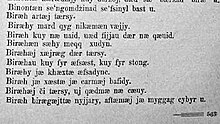Ossetian language
| Ossetian | |
|---|---|
| ирон ӕвзаг (irōn ævzag) дигорон ӕвзаг (digōrōn ævzag) | |
| Pronunciation | [iˈɾon ɐvˈzaɡ] [digoˈɾon ɐvˈzaɡ] |
| Native to | Ossetia |
| Region | Caucasus |
| Ethnicity | Ossetians |
Native speakers | 597,450 (2010)e23 |
| Cyrillic (Ossetian alphabet) | |
| Official status | |
Official language in |
Partially recognised country: |
| Language codes | |
| ISO 639-1 | os |
| ISO 639-2 | oss |
| ISO 639-3 | oss |
| Glottolog | osse1243 |
| Linguasphere | 58-ABB-a |
 Latin-script Ossetian text from a book published in 1935; part of an alphabetic list of proverbs. | |
Ossetian (/ɒˈsɛtiən/, /ɒˈsiːʃən/, /oʊˈsiːʃən/),[1][2] commonly referred to as Ossetic and rarely as Ossete[note 1][8] (ирон ӕвзаг, irōn ӕvzag), is an Eastern Iranian language that is spoken mostly in Ossetia.
Notes[change | change source]
- ↑ The expressions "Ossetic language" and "Ossetian language" are about equally common in books,[3] but dictionaries show that there are differences between British and North American usage. The Collins English Dictionary mentions only "Ossetic" for American usage and lists it first for British usage,[source?] and the US dictionaries Merriam-Webster,[4] Random House,[5] and American Heritage[1] do not even mention the language as a meaning of "Ossetian", whereas the Oxford University Press (as quoted in the Lexico.com entries for Ossetic and Ossete) clearly considers "Ossetian" more common than "Ossetic" for the language. So US dictionaries agree on "Ossetic" for the language, whereas UK dictionaries do not agree on whether it or "Ossetian" are more common. "Ossetic" is apparently preferred in scientific use (linguistics), as shown by this article's references, including the entries in Ethnologue[6] and the Encyclopaedia Britannica.[7]
References[change | change source]
- ↑ 1.0 1.1 AHD:Ossetian
- ↑ OED:Ossetian.
- ↑ "Google Ngram Viewer". Retrieved 2022-03-18.
- ↑ "Ossete". Merriam-Webster.com. Retrieved 19 March 2022.
- ↑ Random House Dictionary
- ↑ "Ossetic". Ethnologue. Retrieved 2019-01-08.
- ↑ Encyclopaedia Britannica
- ↑ Dalby 1998.
Sources[change | change source]
- Dalby, Andrew (1998). Dictionary of Languages: The Definitive Reference to More Than 400 Languages. Columbia University Press. ISBN 978-0-231-11568-1.
